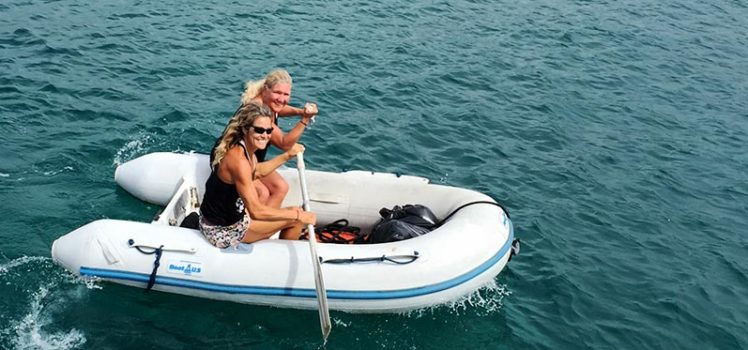Aluminum RIB salt-water corrosion: Problem, yes or no?

Our fiberglass-bottom RIB is over 10 years old and still going strong.
I recently heard a troubling report that a friend’s 3 yr. old aluminum-bottomed RIB was in dire straights. In fact, she was told that it likely had less than 6 months left to live, a result of severe corrosion on the hull. This is the first report that I’ve heard of such a thing, and since our friends just purchased an aluminum RIB, it has started me thinking.
These aluminum-hulled inflatables are relatively new, and because of their light weight when compared to fiberglass, they’re becoming quite popular. I know that if we were shopping for a new RIB right now, they’d be the ones that we’d be looking at closely.
Is our friend’s issue a common one, or is it a product of bad luck, or some strange set of circumstances? To find out, I consulted The Oracle, looking for reports of similar problems. Not to say that they don’t exist, but I spent about an hour this morning searching and couldn’t find a single one.
The corrosion is presumably galvanic in origin. Could it have been caused by stray current in a marina? Would attaching a zinc (sacrificial anode) to the hull have made a difference, and if so, how would you go about doing that?
While I didn’t find any reports of similar problems, I did find this article which discusses how to protect aluminum-hulled boats from salt water corrosion.
Knowing that our blog has some of the smartest and most well-informed readers on the internet (yes, I’m sucking up), I’m curious to hear what info you might have on the subject, and/or your personal experiences.


We pull our aluminum dinghy out of the water each night which keeps the bottom clean and limit any galvanic corrosion.
We do the same. It also makes it hardly to steal!
I am assuming you are talking about me when you “smartest and most well-informed”. Yet I got nothing beyond what was said above and in the article you linked to.. 🙂
You were included in that group. 🙂
Great timing, having just bought a new aluminum RIB we’ve been looking at this. The owners manual for our RIB recommends attaching a zinc to the hull but didn’t list a location. My plan when I get back down to the boat is to check the hull and see if there’s already a spot ready for an anode. We plan to keep ours in davits when not in use but a zinc just seems like cheap insurance for a pricey investment.
No question.
I’ve heard that the aluminum rib’s that have the floor painted or anodized have had problems with corrosion and the material debonding from the hull where the material is attached to the aluminum. I believe going with a bare aluminum hull would be the way to go?
I’ve heard similar. Our friends’ new dinghy is unpainted.
I’m a little surprised they didn’t recommend aluminum anodes for an aluminum hull. I presume because they are relatively new.
The only likely current source is the kicker. A wiring fault. I would check the voltage between the prop and the water when tipped up. Without an anode it should be zero.
Was the corrosion internal or external? Did they use bottom paint?
Good questions, for which I don’t presently have the answers.
We have had ours with al-bottom for seven years now. A bit of wear and tear but no corrosion. Never used any anodes for it. Lift it up most nights but not always. Sometimes we tow it when not going to far in light conditions. Would definitely buy a new one when the time comes.
Thanks, Hakan!
If this was an inexpensive RIB, it may be that the hull was made with an inappropriate grade of aluminum. Not all grades are resistant to salt water corrosion. Marine grade aluminum has grade numbers. Etween 5000 and 5999. Google grades of aluminum for boats and there is a lot of information available.
Inexpensive RIB is a bit of an oxymoron. I know of no such thing. Your point about the grades of aluminum is well taken though.
Here in Australia The “tinnie” is ubiquitous. Our Aluminium dinghy is now 16years old and just starting to be un-repairable as the ally is getting too thin. Never been painted for the first 14years, never had an anode. Hard dinghy is the go for us
I like the name tinnie. 🙂
Our RIB is hauled up every night for a number of reasons, mainly so if we have to move during the night due to wind change, it is not in the way. It is 12 years old and the aluminium is almost as new.
Yes, there are many reasons for “putting the car in the garage” as we call it. We do the same. Always. Thanks for sharing your experience.